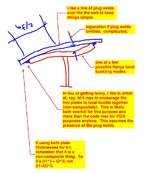A contractor wishes to use a W-section that is a class 4 section (local buckling of flanges).
They said they can weld an additional plate on the compression flange to address the b/t ratio. However, they will only be using stitch welds. How do you check what the minimum amount of weld is required such that the W-section is no longer a class 4 section? Is it simply just enough for the welds to handle the shear flow?
They said they can weld an additional plate on the compression flange to address the b/t ratio. However, they will only be using stitch welds. How do you check what the minimum amount of weld is required such that the W-section is no longer a class 4 section? Is it simply just enough for the welds to handle the shear flow?

